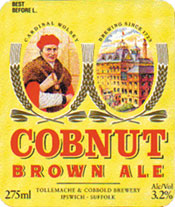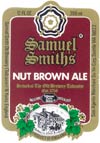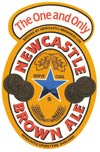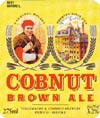
| ||||
| AAB Departments |
| ...Beer Features |
| ...Beer Talk |
| ...Pull Up A Stool! |
| ...What's Brewing |
| ...Beer Travelers |
| ...Stylistically Speaking |
| ...Beer & Food |
| ...Homebrewing |
| ...Collectibles |
| ...Marketplace |
| Beer Lovers' Resources |
| ...World Beer Festival |
| ...Brew Cruise Info |
| ...AAB Merchandise |
| ...AAB Bookstore |
| ...Beer Links |
| About the Magazine |
| ...Subscription Info |
| ...Retail the Magazine |
| ...Advertising Info |
| ...Contact AAB |

|
| All About Beer Magazine • Volume 24 Number 2 • May 2003 |
Brown Ale
by K. Florian Klemp
England's individual beer styles are a result of the golden age of English brewing, the 18th and 19th centuries. Brown ales sit right in the middle. They are unassuming, working-class brews. Imminently drinkable, rich with classic English character, and midway between pale ales and porters, brown ales are ready and able to slake any thirst.
The Roots
 Until about 300 years ago, most English beer was dark, murky, and often dubiously fermented with wild yeast. It had some smoky character, as malt was dried over wood or coal fires. Often, the malt was referred to as "brown malt." At a time when a single malt was used to make beer, it is easy to see why the beers had the character that they did.
Until about 300 years ago, most English beer was dark, murky, and often dubiously fermented with wild yeast. It had some smoky character, as malt was dried over wood or coal fires. Often, the malt was referred to as "brown malt." At a time when a single malt was used to make beer, it is easy to see why the beers had the character that they did.
Multiple batch brewing was common in the Middle Ages. Successive worts were drawn from the mash via saturation and draining of the grist. Each batch produced a lower-strength wort and was designated stout, strong brown, common brown, and intire, in decreasing order of strength. Common brown is an approximation of today's brown ale, but was significantly stronger.
Eventually, malting skills progressed to the point where some specific types of malt were produced. These ran the gamut from pale through amber, brown, and even dark brown. These malts were mixed in different ratios, or used alone, to produce a rainbow of ales, including porter, brown ale, stout, mild, and pale ales, with porter often being the dominant brew. Sometimes, finished beers-some aged, some new-were blended.
By the early 19th century, newly developed pale malts spawned something of a revolution in brewing. Pale ales were brewed extensively in central England, but brown ales held fort in other areas of England as a distinctive alternative, especially in London and later in the northeast. Brown ales were further distilled as a style with the London brewers favoring a darker, sweeter, low-strength beer, while those in the northeast made theirs stronger, crisper, and lighter in color. These two delineations still exist.
The advent of homebrewing and microbrewing in America had yet another profound effect on brown ale formulations. As they were not necessarily beholden to traditional parameters, these experimental brewers played with the ingredients enough to warrant recognition of a neo-brown style. They preserved color and malt character but pushed the hop envelope significantly by using generous amounts for both bittering and aroma. They also brewed to a higher gravity. Brown ale is now a popular brew all across America.
Browns Old and New
The traditional brown ales of England, be they from the northeast or the south, share time-honored brewing procedures and many ingredients. Malts grown in England are known as "maritime" malts, as opposed to "continental" malts, and are called pale ale malt. It generally comprises about 80 to 90 percent of the grist of any ale. Pale ale malt differs from continental malt in several important ways. It is inherently lower in protein and therefore requires less manipulation during the brewing process and less aging after fermentation. Young, fresh ales can be produced in just a few weeks.
Kilning pale ale malt at a slightly higher temperature than continental malt imparts another important difference-a slightly darker, burnished-gold color that contributes a more flavorful, toasty wort.
Modern browns can attribute, in large part, their russet or brown color, distinctive malty aromatics, and flavor to two specialty malts. Comprising a minority of the grist, caramel and chocolate malt cast a prominent influence on brown ales. Stewed and then crystallized, caramel malt contributes a sweet, caramel, and sometimes nutty or toffeeish character. Chocolate malt (lightly roasted pale malt) is somewhat reminiscent of chocolate, but is called such because of its color. The combination of these two malts, in conjunction with the pale malt, makes for a wonderful, deep and complex symphony of flavors and aromas.
It would be a shame to overwhelm such lusciousness with an overdose of hops. To that end, English brown ales are spiked with a balancing measure of the bittering blossoms. Most beers in England employ two varieties of hops, Fuggles and East Kent Goldings. While both are versatile, Goldings are widely considered to be the cream of the crop. They are complex and earthy without being overbearing. Their distinctly herbal character has much to do with giving a brew that decidedly "British" ambiance. Fuggles, also first cultivated in Kent and widely used, contribute a rounder, but just as earthy note. Flavor and aroma hop additions are usually modest.
Ale brewers in England tend to favor yeasts that contribute a wee bit of a footprint to the finished beer. One great thing about yeast is that over time, it adapts to house conditions and the practices of the brew master. In this sense, many strains are proprietary, meaning that they are considered the "house yeast" that is used nowhere else. This effect is often what produces the minute, discernable differences from one brewery to another. Working at relatively high temperatures, yeasts produce various esters and other distinct qualities generally associated with, and desired in, ales. Faint butterscotch notes, soft fruity esters, and even winey wisps drift from glass to nose. What brown ales lack in force, they make up for with subtle expression.
American versions of brown ale are, at first glance, indistinguishable from their British counterparts. Some are, in fact, designed to mimic the English browns in every way. The ruby-brown colors are there, as the grist is about the same, being comprised of pale, caramel, and chocolate malts for the most part. But often, that is where the similarity ends. An initial whiff reveals that something is absent, but something else is aggressively present. Missing are the subtle contributions of the yeast, as American browns are often made with a neutral yeast with little or no character of its own. Present, however, is a forceful dose of aroma hops with the very familiar Cascade variety the most common. A taste will reveal yet another divergence from the English browns. American browns are bigger in all ways-higher in gravity, bitterness, and alcohol.
Finding Browns
Precious few English browns find their way to North America. The most common are Samuel Smiths Nut Brown, Tollemache and Cobbold Cobnut Brown Ale, and the ubiquitous Newcastle Brown.
There is no dearth of American-made browns. Many brewpubs have them along side the requisite pale ale, porter or stout. One is just as likely to find English brown clones as the Americanized versions. Bottled US browns are also quite common, some of the best being Acme Brown from North Coast Brewing Co., Bell's Best from the Kalamazoo Brewing Co., Nutrageous Brown of Rock Creek Brewing Co., Brooklyn Brown of Brooklyn Brewing Co., and Downtown Brown of Lost Coast Brewing Co.
Brown ales are in many ways underappreciated and tend to blend into the beer landscape. They are worthy of attention, however, as they blend complexity and drinkability like few other brews. From the soft, mellow browns of London, to the big, aromatic hops-amok browns of America's microbreweries and brewpubs, there is something for everyone. Originally, that was the intent of brown ale, something that could be enjoyed and savored by all.
------------------------------
Tasting Notes
 |
Samuel Smiths Nut Brown Ale |
 |
Newcastle Brown Ale |
 |
Tollemache and Cobbold Cobnut Brown Ale |
 |
Mash House Nut Brown Ale |
 |
Pete's Wicked Ale |
-------------------------
K. Florian Klemp is a research analyst at Duke University in Durham, NC, and an award-winning homebrewer.









